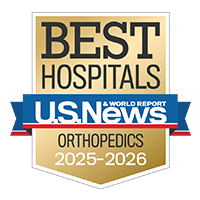Biceps Tendinitis

Overview
While shoulder pain has many possible causes, a common reason for it in people under the age of 50 is biceps tendinitis. This happens when the long head of the biceps tendon, which connects the biceps muscle to the shoulder blade, becomes inflamed. The swelling can be quite painful.
There are actually two biceps tendons, a long head and a short head. The short head tendon inserts outside the shoulder joint and rarely causes pain, while the long head tendon is covered with tissue that's rich in nerve endings and easily inflamed. The biceps muscle's main job is to help supinate the forearm, which is the motion of rotating your inner forearm so that it faces up.
Our approach to biceps tendinitis
UCSF is committed to helping patients with biceps tendinitis recover shoulder function and return to their favorite activities. Using methods shown to work and individualizing the plan for each patient, our team includes orthopedic surgeons, primary care sports medicine doctors, physical therapists and athletic trainers.
Treatment for biceps tendinitis depends on the injury's cause and severity. We usually begin with a combination of rest, anti-inflammatory medications and physical therapy. Some patients benefit from a steroid injection to decrease inflammation. These techniques are usually effective, so surgery is rarely needed.
Awards & recognition
-

Among the top hospitals in the nation
-

Best in Northern California and No. 6 in the nation for orthopedic care
Signs & symptoms
People with biceps tendinitis commonly experience:
- Recurrent or constant pain, particularly with overhead activities and sports
- Pain at the front of the shoulder, making it sore to the touch
Diagnosis
Doctors diagnose biceps tendinitis by taking the patient's medical history, performing a physical exam, and evaluating imaging studies – usually X-rays, though sometimes MRI or ultrasound. The physical exam typically reveals a sore spot on the front of the shoulder, and patients experience pain with lifting and actions such as throwing. X-ray images provide information on the shoulder joint, while an MRI or ultrasound can help the doctor check for other shoulder problems.
Treatments
For most patients, the initial treatment plan features some combination of these nonsurgical remedies:
- Rest. If the inflammation is partly due to overuse, resting the shoulder may help.
- Nonsteroidal anti-inflammatory drugs (NSAIDs). These oral medications are used to control pain by decreasing the inflammation around the biceps tendon.
- Strengthening and stretching exercises. Doctors often prescribe a physical therapy program, which may be done at home or under the supervision of a physical therapist. The goal is to strengthen the muscles around the shoulder, which in turn decreases the stress on the inflamed biceps tendon.
- Corticosteroid injections. Corticosteroids can reduce pain by decreasing inflammation, smoothing the way to recovery. Ultrasound imaging may be used for placing these injections.
Surgery
For patients who don't achieve satisfactory results from the treatments discussed above, surgery is an option. The minimally invasive procedure – requiring only a small incision at the front of the shoulder – is called a biceps tenodesis and takes 45 to 60 minutes.
A majority of biceps surgeries are performed arthroscopically (using an arthroscope, which is an endoscope for joints) at the UCSF Orthopaedic Institute. Patients are under general anesthesia (completely asleep) and given a nerve block (an injection that interrupts pain signals in the area and lessens post-op pain). Other shoulder problems may also be addressed during the procedure. The surgical technique involves changing the tendon's normal attachment point at the shoulder socket to a point farther down the upper arm bone.
Recovery from biceps surgery
Patients generally must use a sling for four to six weeks to allow the tendon to heal securely in its new position. During that time, driving is restricted and physical therapy is limited to passive range-of-motion exercises, which prevent shoulder stiffness while protecting the repair. Most people with desk jobs can return to work around the second week post-op, but people with active or strenuous jobs may need to complete four months of physical therapy before they can safely return.
At week six, the sling is removed and physical therapy begins to incorporate active range-of-motion exercises without the use of weights. Patients can resume jogging and doing other lower-body exercises as well.
At week 12, physical therapy can begin focusing more on building strength. The program generally continues until about month four, and a full return to activities is allowed between five and six months. At six months, the repair is considered completely healed.
UCSF Health medical specialists have reviewed this information. It is for educational purposes only and is not intended to replace the advice of your doctor or other health care provider. We encourage you to discuss any questions or concerns you may have with your provider.
Where to get care (3)
Frequently Asked Questions
- When can I shower after surgery?
You'll need to keep the incision clean and dry until your first post-op visit, one to two weeks after surgery. At that time, you'll likely be cleared to shower, but don't submerge the surgical site in a bath or swimming pool until three to four weeks have passed since your surgery.
- When can I drive after biceps surgery?
You'll be in a sling and unable to drive for four to six weeks. You may resume driving when the sling is off and you feel you have appropriate control to do it safely.
- When can I return to work?
Most patients are ready to return to school or desk work five to seven days after surgery. If you're able to work from home, your initial recovery period may be easier. If you have a physically demanding job that requires overhead lifting or strenuous arm work, you'll need more time before you can safely resume working.
- When can I return to my usual activities?
Patients are generally able to resume most activities between four and six months after biceps surgery.









